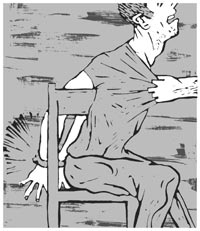Utterly Forbidden: The Torture And Ill-Treatment Of Palestinian Detainees
Global Research, May 7, 2007 | ||||
B'Tselem - 2007-05-02 | ||||
Joint report with Hamoked - Center for the Defence of the Individual, The Legal FrameworkInternational law absolutely prohibits torture and ill-treatment. States may not derogate from this prohibition even in the harsh circumstances of fighting terrorism. The responsibility, in case of violation, rests not just with the state, but also with the individual abusers who may face prosecution in other countries. In its ruling from September 1999, the HCJ determined that the ISA did not have legal authority to use "physical means" against interrogees. Pressure and a measure of discomfort are legitimate, according to this judgment, only as a side-effect of the necessities of the interrogation and not as a means for breaking the interrogees' spirit. However, it was established that ISA agents who abused interrogees in "ticking bomb" situations may avoid prosecution. This ruling implicitly legitimized these severe acts, contrary to international law, which does not acknowledge any exceptions to the prohibition on torture and ill-treatment. The "Softening Up" of Detainees Prior to Interrogation The witnesses reported being subjected to beating, painful binding, swearing and humiliation and denial of basic needs at the hands of security forces personnel from the moment of arrest until being transferred to the ISA. About two thirds of the witnesses (49 of 73) reported that they had undergone at least one of these forms of abuse, which are defined by international law as ill-treatment and may reach the level of torture. This research did not examine the question whether this ill-treatment was intended to "soften up" the detainees for the ISA interrogations. It is, however, its practical outcome. The ISA Interrogation System: Routine Ill-treatment The ISA interrogation system includes seven key aspects which harm, to varying degrees, the dignity and bodily integrity of the detainees. This injury is intensified considering the combined exercise of these aspects during the interrogation period which, for the witnesses in the sample, lasted an average of 35 days:
These methods were employed against the vast majority of witnesses included in the sample. These measures are not inevitable side-effects of the necessities of detention and interrogation, but are rather intended to break the spirit of the interrogees. As such, they deviate from the HCJ ruling and constitute, under international law, prohibited ill-treatment. Moreover, under certain circumstances, these measures may amount to torture. "Special" Interrogation Methods In addition to routine measures, in some cases, probably those considered "ticking bombs", ISA interrogators also use "special" methods which mostly involve direct physical violence. The sample witnesses described seven such methods:
These measures are defined as torture under international law. Their use is not negligible, even if not routine. The HCJ did rule that ISA interrogators who abused interrogees in "ticking bomb" situations may be exempted from criminal liability, but this only when the ill-treatment was used as a spontaneous response by an individual interrogator to an unexpected occurrence. In practice, all evidence points to the fact that "special" methods are preauthorized and are used according a preset regulations. Cover up and Whitewashing Mechanisms The ill-treatment and torture of Palestinian detainees by soldiers and ISA interrogators do not take place in a void, but rather under the auspices of the Israeli law enforcement system. Despite the fact that since 2001 the State Attorney's Office received over 500 complaints regarding ill-treatment by ISA interrogators, it has not found cause to order the instigation of a single criminal investigation. The State Attorney's decisions on this issue are based on the findings of an examination conducted by the "Inspector of Complaints by ISA Interrogees," who is an ISA agent, answerable to the head of the organization. Even when the findings have shown that ISA interrogators did indeed abuse an interrogee, the State Attorney's Office has closed the file based on a biased interpretation of the ruling regarding the applicability of the "necessity defense" in the HCJ 1999 judgment. Most cases of ill-treatment of Palestinians by soldiers are not investigated at all, and few of those that do, culminate in an indictment. In many cases, this is due to various institutional failings such as delays in instigation investigations. Additionally, it may be assumed that without concerted and proactive efforts on the part of the authorities, the chances of detainees submitting complaints regarding injuries they have suffered during their arrest are quite low. The ISA interrogation system is significantly aided by the HCJ, which serves as a rubber stamp on orders which regulate the isolation of the interogees from the outside world. The HCJ did not accept even one of the hundreds of petitions brought before it against such orders. The HCJ also routinely allows the ISA to conceal from the detainees the very fact that an order against them has been issued as well as the legal proceedings taking place in their case. All this with the purpose of increasing the psychological pressure employed against them. Recommendations
These measures are defined as torture under international law. Their use is not negligible, even if not routine. The HCJ did rule that ISA interrogators who abused interrogees in "ticking bomb" situations may be exempted from criminal liability, but this only when the ill-treatment was used as a spontaneous response by an individual interrogator to an unexpected occurrence. In practice, all evidence points to the fact that "special" methods are preauthorized and are used according a preset regulations. | ||||




0 Comments:
Post a Comment
<< Home